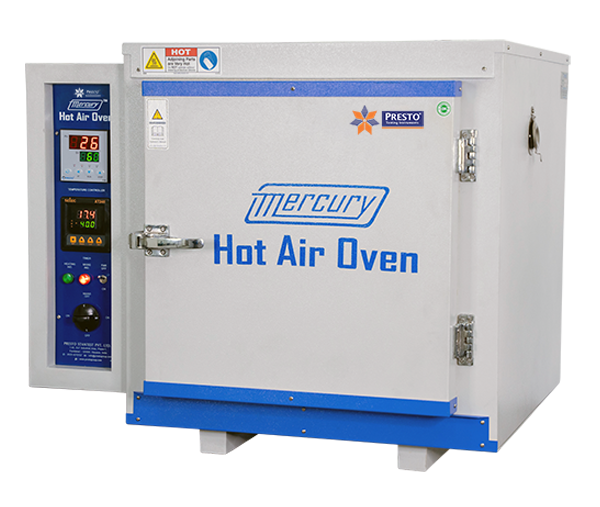

Sterilization is a very important step in making sure there is no contamination in labs, hospitals, and industries. Two most used methods for sterilization are hot air ovens and autoclaves. While both can kill microorganisms, their working method, usage, and efficiency are different. So, which one is best for dry sterilization — hot air oven or autoclave? Let’s understand deeply.
A hot air oven is a machine that uses dry heat to sterilize tools and materials. It works based on the conduction principle, where heat goes from the outside of the object into the center.
It heat up the air in the chamber to high temperatures usually 160°C to 180°C for a fixed time. The high heat destroys bacteria, spores and other microbes by oxidizing their cell parts.

An autoclave use moist heat (steam) under high pressure to sterilize things. It usually runs at 121°C at 15 psi pressure for about 15–30 minutes, depends on the items.
It works by pushing steam inside the materials, and the heat destroys proteins of microbes. This is very effective against bacteria, viruses and even spores.

| Feature | Hot Air Oven | Autoclave |
| Sterilization Type | Dry Heat | Moist Heat |
| Temperature | 160°C–180°C | 121°C |
| Time Taken | 2 to 3 hours | 15–30 minutes |
| Pressure | Not needed | Needed (15 psi) |
| Best For | Glass, powders, metal | Surgical items, textiles, liquids |
| Energy Use | More energy due to long cycles | Less energy, shorter cycles |
| Price | Mostly cheaper | Expensive |
| Sterilization Quality | Good, but not best for spores | Excellent, very effective |
| Use in Labs | For dry things like glass | For moist items like media, cloth etc. |
If your need is only dry sterilization, then hot air oven is better.
Still, if you want fast, deep sterilization for general items, then autoclave is more better.
Choosing between hot air oven and autoclave depends on what you are sterilizing.
So, for dry sterilization only, hot air oven is your best option. But for wider applications, autoclave gives more reliable results.
Q1: Can a hot air oven replace an autoclave?
Ans: Not really, Both are used for different stuff. A hot air oven is fine for dry materials like glass and metal tools, but if you’re sterilizing moist items like surgical instruments or cotton, then autoclave is a must. Steam does a better job at killing germs and spores.
Q2: Which one is faster – autoclave or hot air oven?
Ans: Autoclave is definitely quicker. It takes like 15 to 30 minutes with steam under pressure. A hot air oven? That might need 1.5 to 2 hours at 160°C. So yeah, if you want speed, autoclave wins hands down.
Q3: Is dry heat better at killing bacteria?
Ans: Dry heat works for some things, but moist heat is more powerful. Steam goes deeper and kills a wider range of bacteria and even spores. That’s why autoclaves are the go-to in hospitals and labs. So, dry heat is okay, but steam heat is stronger.
Q4: What’s the usual time and temp setting for hot air ovens?
Ans: Most people use 160°C for 2 hours or 180°C for around 30–40 minutes. These are standard sterilization settings. But yeah, it’s important the oven actually reaches that temp and stays there for the full time, otherwise the sterilization won’t be proper.
Q5: Is a hot air oven cheaper than an autoclave?
Ans: Yes, it is. Hot air ovens are simpler machines, so they cost less and are easier to maintain. If you’re only working with dry stuff, it’s a budget-friendly option. But for full-on sterilization, especially moist items, autoclave is still the better choice.
Want to buy the best hot air oven or autoclave? Whether for your lab, hospital or factory, always select trusted brands with tested quality.
Call us today at +91 9210 903 903 or mail at info@prestogroup.com to get expert help!
Related Blogs

An autoclave is a device that sterilizes equipment using high-pressure saturated steam, ensuring complete elimination of microbes.

Discover key tensile test methods for metals, plastics, and polymers. Learn procedures, equipment, and factors affecting tensile strength and material performance.

Explore everything about Vibration Chambers—definition, working, and key features. Find expert insights and the most affordable Vibration Chamber price in India.